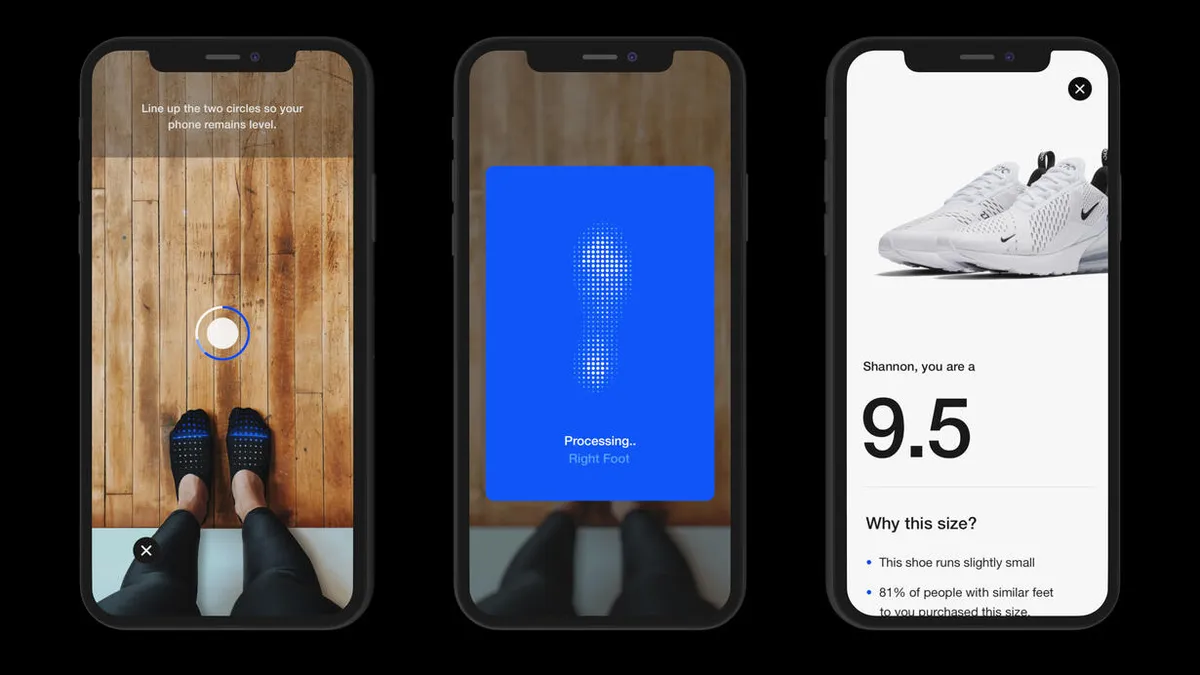Nike's status as a technology company has almost overtaken its status as an athletics retailer in recent years. The company made waves in 2018 with its introduction of the Nike Live store concept, a members-only store that relied heavily on the mobile app, and later that year the House of Innovation flagship concept, which had similar features.
Those concepts rely on the convenience of a variety of mobile capabilities, including mobile pickup spots, mobile self-checkout kiosks and features that let shoppers identify clothes hanging on a mannequin, or request a certain shoe size and color from a nearby store associate.
Nike's latest advancement pushes the utility of its app even further. A new feature employs computer vision and the user's smartphone camera to scan a customer's feet and come up with a digital foot morphology, and then applies that to the company's various shoe designs, providing customers with the recommended shoe size for them in each of the company's footwear products.
Store associates, or "athletes" as Nike calls them, have the technology enabled on mobile devices they carry around in stores. Customers can also use the feature at home and save the digital scan to their Nike Plus profile so that every time a shoe is selected their recommended size will already be pulled up.
Since a customer's size will likely vary by product, the app also includes a summary for why a certain shoe size was selected: perhaps because a shoe runs small or large, or perhaps because other people with similarly sized feet purchased this size. No matter what it is, Nike has a reason.
You can't 'just do it' with shoes that don't fit
The impetus for Nike Fit, which has been tested in three stores for the past six months and is set to roll out to all U.S. stores in early July, was an industry-wide sizing challenge. But it was also one that Nike heard complaints about, according to Michael Martin, Nike's vice president of Nike Direct product and growth.
"Bad fit is a barrier to sport. If your shoes don't fit well, then you're not going to perform as well and perhaps you're not even going to engage in sport that day," Martin said in an interview, commenting on the brand's mission to get more customers out and active every day. "It's also a pretty big brand risk, frankly … We have people who say, 'I love Nikes, they're so cool, but they just don't fit me. The whole brand — you just don't fit me,' and that is not a great situation for us to be in."
Nike Fit aims to combat that by helping customers find not only a general shoe range for Nike's products, but a per-product shoe size that factors in everything from performance intent to a customer's personal preferences. The former is easier for Nike to get a handle on, as the retailer (and now its computer vision technology) knows the purpose of each shoe. For example, a soccer cleat may need a tighter fit than the relaxed fit of a casual sneaker.
For intel on what shoe fit an individual shopper might prefer, Nike's technology pulls from people with similar foot morphologies, essentially the details of the anatomy of your foot, which frequently have comparable preferences, especially when it comes to performance footwear, according to Martin. While the company intends to give customers an ideal fit the first time around, the technology is set up so that a user on the app can change their preferences if, say, they order a pair of shoes online and find a different size more comfortable than what is recommended. Marking a shoe size as preferred feeds back into the technology's artificial intelligence, which learns from a user's selections over time and improves its recommendations.
Why doesn't Nike just use the data to better standardize its sizes? According to Martin, that's easier said than done. The lasts (shoe models), materials, lacings and performance intent for each style is different from the next, and the wide variety of foot shapes make it difficult to remove the fit variance for a given customer.
"This is not about improving sizing because sizing is a lie, from our perspective," Martin said. "It's a gross simplification of a multifactorial complexity."
Nike Fit is a way for the retailer to account for that, and also a way to get its shoppers used to the notion that even though they've always thought of themselves as a size 6, it may not be the ideal fit for them in every product.
Becoming a tech company
The Nike Fit journey started with the acquisition, about a year ago, of computer vision firm Invertex. Nike executives knew what challenges they faced in footwear and what they wanted to do, but needed more tech experience. At the time, they were intentionally quiet about why they acquired Invertex, saying the company would help them with "groundbreaking innovations."
Even now, after announcing Nike Fit, the retailer is keeping further applications of the technology close to its chest. The possibilities for Nike Fit to expand to include other pieces of apparel — athletic shirts, shorts and bras, for example — seem natural, but for now, Martin would only hint that these potential uses, "are very interesting and not without notice."
Regardless, figuring out footwear is Nike's first priority with the new tech. In addition to helping customers find the right size in current models, data gathered from customers will also inform product development with an eye towards enacting meaningful changes in the shoe design and manufacturing process.
"This is about transforming the way we operate overall," Martin said. "So we will and are already in the process of using this data from the thousands of people who went through our stealth tests to take a look at our lasts and understand which ones of them better represent our consumer's population as a whole, and we'll continue down that path."
The retailer is also planning to use the data to adjust its buy depth: essentially, how much of an individual product and an individual size that the company buys. Over time, the hope is that Nike products will be a better fit for customers across the board, rather than using the technology to create custom-made shoes. Custom-created shoes are not only expensive and environmentally unfriendly, but Martin also believes that their current approach will create a better fit than custom-made shoes would.
"Fundamentally, where we want to take it is this: Where you're no longer a number, you're no longer a gender on the box, you're just a name. This is just your shoe … this is the perfect fit, the best fit possible for you," he said. "And we think that not only are we able to achieve that, but we're going to be able to go further than that because the information that our members share with us will allow us to design better and better shoes over time."






















